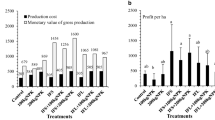Abstract
Wheat was grown continuously in soil amended with 5 levels of superphosphate and with 4 levels of urea at 3 sites. The incidence and severity of take-all, caused byGaeumannomyces graminis var.tritici, declined with increasing rates of application of both superphosphate and urea.
In both years, the severity of take-all on plants receiving neither superphosphate nor urea was about 40% while at the highest level of superphosphate and urea supply the take-all severity was approximately halved at 22%.
There was an increase in grain yield in response to applied superphosphate and urea to the highest level of each nutrient. There was also an increase in the 1,000-kernal weights with superphosphate and urea fertilizer application.
Similar content being viewed by others
References
AOAC (1975) Official Methods of Analysis. 12th Edn. (Association of Official Analytical Chemists, Washington, D.C.)
Brennan RF (1988) Effect of phosphorus deficiency in wheat on the infection of roots byGaeumannomyces graminis var.tritici. Aust J Agric Res 39: 541–546
Brennan RF (1989) Effect of nitrogen and phosphorus deficiency in wheat on the infection of roots byGaeumannomyces graminis var.tritici. Aust J Agric Res 40: 489–495
Butler FC (1961) Root and foot rot diseases of wheat. Sci Bull Depart of Agric NSW 77: 5–97
Colwell JD (1963) The estimation of phosphorus fertilizer requirements of wheat in southern New South Wales by soil analysis. Aust J Exp Agric Ani Husb 3: 190–197
Cotterill PJ and Sivasithamparam K (1988) Survival of the take-all fungus in the presence and absence of susceptible grasses. Aust J Soil Res 26: 313–322
Curl EA (1963) Control of plant diseases by crop rotation. Bot Rev 29: 413–479
Day PR (1965) Particle fractionation and particle size analysis. In: Methods of Soil Analysis, Part 1. (Ed. C.A. Black). Agronomy Monographs No. 9, p. 545
Garrett SD (1941) Soil conditions and the take-all wheat. VI. The effect of plant nutrition upon disease resistance. Ann Appl Biol 28: 14–18
Garrett SD (1948) Soil conditions and the take-all of wheat. IX. Interaction between host nutrition, disease escape and disease resistance. Ann Appl Biol 35: 14–17
Glynne MD (1965) Crop sequence in relation to soilborne pathogens. In: Ecology of Soil Borne Pathogens. (Eds KF Baker and WC Snyder). pp. 423–435. (Uni. of California Press, Berkeley)
Graham RD (1983) Effects of nutrient stress on susceptibility of plants to disease with particular reference to the trace elements. Adv Bot Res 10: 221–276
Hesse PR (1971) A Textbook for Soil Chemical Analysis. Ch. 14, p. 355. (J. Murray, London)
Hornby D (1985) Soil nutrients and take-all. Outlook Agric 14: 122–128
Hornby D and Goring CAI (1972) Effects of ammonium and nitrate nutrition on take-all disease of wheat in pots. Ann Appl Biol 70: 225–231
Huber DM (1972) Spring versus fall nitrogen fertilization and take-all of spring wheat. Phytopath 62: 434–436
Huber DM (1980) The role of mineral nutrition in defence. In: Plant Disease. An Advanced Treatise'. (Eds. JG Hotsfall and EB Cowling) pp. 381–406. (Academic Press, New York)
Huber DM (1981) The use of fertilizers and organic amendments in the control of plant disease. In: CRC Handbook of Pest Management in Agriculture. (Ed. D Pimentel). pp. 357–394. (CRC Press, Inc., Boca Raton, Florida)
Huber DM and Watson RW (1974) Nitrogen form and plant disease. Ann Rev Phytopath 12: 139–165
Isaac RA and Johnson WC (1976) Determination of total nitrogen in plant tissue using a block digestor. J Assoc Offic Agric Chem 59: 98–100
MacNish GC (1980) Management of cereals for control of take-all. J Agric Western Australia 21 (4th series): 48–51
MacNish GC and Speijers J (1982) The use of ammonium fertilizers to reduce the severity of take-all (Gaeumannomyces graminis var.tritici) on wheat in Western Australia. Ann Appl Biol 100: 8390
Northcote KH (1979) A Factual Key for the Recognition of Australian Soils. 4th Edn. (Rellim Technical Publications, Glenside, South Australia)
Pym RVE and Milham PJ (1976) Selectivity of reaction amongst chloride, ammonium and salicylate for determination of ammonium. Anal Chem 48 1413–1415
Reis EM, Cook RJ and McNeal BL (1982) Effect of mineral nutrition on take-all of wheat. Phytopath 72: 224–229
Reuter DJ (1986) Temperate and Sub-tropical Crops. In: Plant Analysis: An Interpretation Manual. (Eds. DJ Reuter and JB Robinson). pp. 38–99. (Inkata Press, Melbourne)
Sadasivan TS (1965) Effect of mineral nutrients of soil micro-organisms and plant disease. In: Ecology of Soil-Borne Plant Pathogen. Prelude to Biological Control. (Eds. KF Baker, WC Snyder, RR Baker, JD Menzies). pp. 460–469. (University of California Press, Berkely, Los Angeles)
Salt GA (1959) Effect of nitrogenous fertilizer applied at different dates on take-all, eyespot and yield of winter wheat grown on light sandy loam. Ann Appl Biol. 47: 200–210
Sims HJ, Meagher JW and Millikan CR (1961) Dead heads in wheat — field studies in Victoria. Aust J Exp Agric Ani Husb 1: 99–108
Smiley RW and Cook RJ (1973) Relationship between take-all of wheat and rhizosphere pH in soils fertilized with ammonium vs nitrate nitrogen. Phytopath 63: 882–890
Stumbo CR, Gainey PL and Clark FE (1942) Microbial and nutritional factors in the take-all disease of wheat. J Agric Res 64: 653–665
Syme JR (1966) Fertilizer and varietal effects on takeall in irrigated wheat. Aust J Exp Agric Ani Husb 6: 246–249
Walkley A and Black IA (1934) An examination of the Degtjareff method for determining soil organic matter and a proposed modification of the chromic and titration method. Soil Sci 37: 29–38
Zadoks JC, Chang TT and Konzack CF (1974) A decimal code for the growth stages of cereals. Weed Res 14: 415–421
Author information
Authors and Affiliations
Rights and permissions
About this article
Cite this article
Brennan, R.F. Effect of superphosphate and nitrogen on yield and take-all of wheat. Fertilizer Research 31, 43–49 (1992). https://doi.org/10.1007/BF01064226
Received:
Accepted:
Issue Date:
DOI: https://doi.org/10.1007/BF01064226




